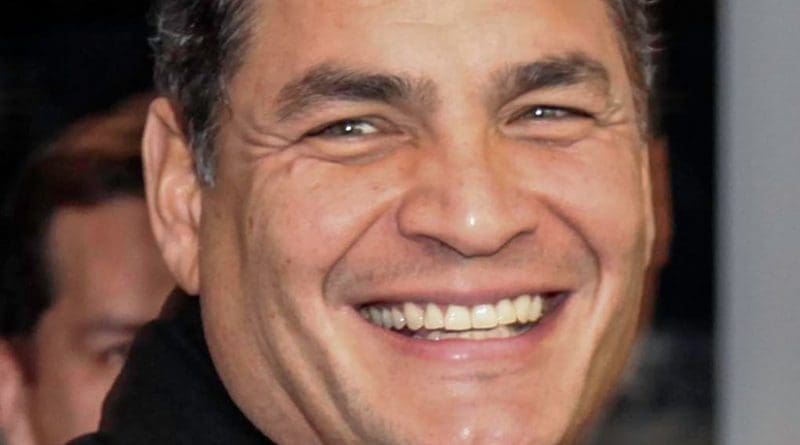Ecuador After Ten Years Of President Correa – Report
By CEPR
A new report from the Center for Economic and Policy Research (CEPR) looks at key economic and social indicators, as well as policy, institutional, and regulatory changes in Ecuador in the decade since President Rafael Correa took office. The paper also looks at how the government dealt with the 2008–2009 world financial crisis and recession, and then a second oil price collapse beginning in 2014.
“The reforms and macroeconomic policy changes over the past decade, some of which were quite innovative, seem to have allowed for significant economic and social progress ― despite two major external economic shocks that triggered recessions in Ecuador,” said CEPR Co-Director and economist Mark Weisbrot, a coauthor of the paper.
Among the highlights, the paper finds:
- Annual per capita GDP growth during the past decade (2006–2016) was 1.5 percent, as compared to 0.6 percent over the prior 26 years.
- The poverty rate declined by 38 percent, and extreme poverty by 47 percent ― a reduction many times larger than that of the previous decade. This resulted from economic growth and employment, and from government programs that helped the poor, such as the cash transfer program Bono de Desarollo Humano, which more than doubled in size as a percent of GDP.
- Inequality fell substantially, as measured by the Gini coefficient (from 0.55 to 0.47), or by the ratio of the top 10 percent to the bottom 10 percent of the income distribution (from 36 to 25, as of 2012).
- The government doubled social spending, as a percentage of GDP, from 4.3 percent in 2006 to 8.6 percent in 2016. This included large increases in spending on education, health, and urban development and housing.
- There were significant gains in education enrollment at various levels, as spending on higher education increased from 0.7 to 2.1 percent of GDP. This is the highest level of government spending on higher education in Latin America, and higher than the average of the OECD countries.
- Government expenditure on health services doubled as a percentage of GDP from 2006 to 2016.
- Public investment increased from 4 percent of GDP in 2006 to 14.8 percent in 2013, before falling to about 10 percent of GDP in 2016.
The paper notes that these results were not driven by a “commodities boom,” but from deliberate policy choices and reforms that the Correa government enacted, including ending central bank independence, defaulting on illegitimate debt, taxing capital leaving the country, countercyclical fiscal policy, and ― in response to the most recent oil price crash ― tariffs implemented under the WTO’s provision for emergency balance of payments safeguards.
“Ecuador’s experience over the last ten years indicates that a relatively small, lower-middle income developing country is less restricted in its policy choices by ‘globalization’ than is commonly believed,” Weisbrot said.


Regardless of his detractors there should be no question that President Correa did more for the country than any of the previous leaders. Not only did he vastly improve the plight of the poor, but he also elevated the stature of Ecuador in the world. Prior to President Correa Ecuador wasn’t even on the map of the countries most favored to move to or visit. Thanks to him Ecuador rated number one for three years in a row. His policies to wrestle control from the banks and the US were not always popular and some things were out of his control, such as the falling price of oil, but he did well with what he had. Did he make everyone happy? No. There isn’t a leader who does, but he was the most popular leader in Latin America and his ten year term speaks for itself.
He’s literally been in power for ten years because he amended the constitution to make indefinite re-election possible, you are going to tell me that’s not essentially a dictatorship? Also, you might not know this, but fear and police oppression has played a major role in keeping Correa in power, after all, how can people oppose him and protest, if they are afraid to do so.
Not true.
In Ecuador presidents, can be re-elected only once. President Rafael Correa did not support the movement to change the constitution via referendum to allow more re-elections or indefinite re-election. He has been in power for ten years because his first presidency was cut short after the constitution was changed by the Asamblea Constituyente, a democratic process with all his members elected. Under the new constitution, he won by landslides 2 more times. His popularity remains very high, and that is what keeps him in power not police oppression. He is very popular because he has prioritized social investments Health, Education, Ecuador is one of the few countries where inequality is reducing. He also massively improved infrastructure.
Sure, there is bad and ugly, he has a very thin skin, the war with the media, private sector lacks of substantial grow, lately allegation of corruption for member of his government (Panama Papers and Odebrech) to mention a few. Obviously, we are still a struggling country but Rafael Correa presidency has accomplished a lot. The new president has big shoes to fill.